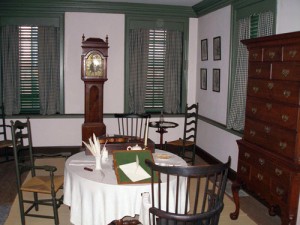 The celebration of American Independence Day on the Fourth of July has come to include parades, barbecues and fireworks. The celebrations should include discussions of how the Declaration of Independence came to be. The story began in Part One as The Committee of Five appointed to draft a declaration of independence had dwindled in reality to just Thomas Jefferson and John Adams, since most members of Congress thought that drafting the declaration was necessary, but not really important. Part Two has Jefferson and Adams agree to the declaration’s form. Part Three explores Jefferson’s state of mind following his meeting with Adams, as Jefferson himself is more concerned with events in Virginia than an independence declaration. In Part Four, Jefferson’s selection to draft the declaration takes place. In Part Five, Jefferson considers the lessons of history as he begins work on the Declaration.
The celebration of American Independence Day on the Fourth of July has come to include parades, barbecues and fireworks. The celebrations should include discussions of how the Declaration of Independence came to be. The story began in Part One as The Committee of Five appointed to draft a declaration of independence had dwindled in reality to just Thomas Jefferson and John Adams, since most members of Congress thought that drafting the declaration was necessary, but not really important. Part Two has Jefferson and Adams agree to the declaration’s form. Part Three explores Jefferson’s state of mind following his meeting with Adams, as Jefferson himself is more concerned with events in Virginia than an independence declaration. In Part Four, Jefferson’s selection to draft the declaration takes place. In Part Five, Jefferson considers the lessons of history as he begins work on the Declaration.
Thomas Jefferson had skipped the afternoon session of the Second Continental Congress on June 13, 1776. Sitting in his apartment he became reconciled that he would not be in Virginia to participate in the drafting of the Virginia Constitution, and that his lot would be to draft a declaration in to explain the American move to independence if the resolution for independency were adopted on July 1st.
His initial thought when meeting with John Adams yesterday about the declaration was that there might be some guidance in the project from history. It was time to look for that guidance in historical events.
Magna Carta
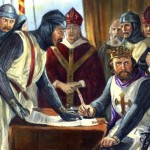 In recent days, Jefferson had discussed with Richard Henry Lee how Pennsylvania’s John Dickinson so often invoked Magna Carta. He was of a mind with Lee how that document was the result of the English nobility seeking a secure place in the feudal system, negotiated at knife point. Jefferson considered the politics of Magna Carta’s resurrection over 400 years after it had been annulled by the pope. Chief Justice Edward Coke had been telling King James I that it was still in effect and it limited the King’s power. Jefferson thought it likely James couldn’t read Magna Carta’s original Latin and Coke could. Magna Carta had never been the source of any rights, but Jefferson admired Lord Coke’s ingenuity.
In recent days, Jefferson had discussed with Richard Henry Lee how Pennsylvania’s John Dickinson so often invoked Magna Carta. He was of a mind with Lee how that document was the result of the English nobility seeking a secure place in the feudal system, negotiated at knife point. Jefferson considered the politics of Magna Carta’s resurrection over 400 years after it had been annulled by the pope. Chief Justice Edward Coke had been telling King James I that it was still in effect and it limited the King’s power. Jefferson thought it likely James couldn’t read Magna Carta’s original Latin and Coke could. Magna Carta had never been the source of any rights, but Jefferson admired Lord Coke’s ingenuity.
He agreed with Lee that a document signed by King John under duress, revoked by the pope, forgotten for 400 years and used by Coke to enhance his own authority was not a likely place to look for inspiration in constructing a declaration of American independence.
The Declaration of Arbroath
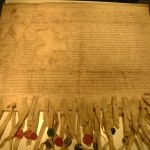 Jefferson moved from that ancient document to his studies with Professor William Small at William and Mary College in Williamsburg. Professor Small was a Scotsman from Aberdeen who had introduced Jefferson to many subjects and philosophers, among them John Locke. Small was a professor of philosophy with a pride in his Scottish heritage.
Jefferson moved from that ancient document to his studies with Professor William Small at William and Mary College in Williamsburg. Professor Small was a Scotsman from Aberdeen who had introduced Jefferson to many subjects and philosophers, among them John Locke. Small was a professor of philosophy with a pride in his Scottish heritage.
Small had brought to Jefferson’s attention a document of particular pride to Scotsmen, the 1320 Declaration of Arbroath. Over 450 years before Jefferson was given this task, the Scots were searching for a way to end their domination by an English king. A group of Scottish nobles sent a letter to Pope John XXII requesting him to rescind papal recognition of Edward II and recognize Robert the Bruce as King of Scotland.
Jefferson had read the Declaration of Arbroath in the original Latin and remembered its litany of Edward II’s abuses:
“The deeds of cruelty, massacre, violence, pillage, arson, imprisoning prelates, burning down monasteries, robbing and killing monks and nuns and yet other outrages without number which he committed against our people, sparing neither age nor sex, religion nor rank, no-one could describe nor fully imagine unless he had seen them with his own eyes.”
Jefferson noted the Arbroath Declaration contained a list of royal abuses and that was of use for his own current project. That declaration however was not really about independence. The Scottish Barons had requested a single man, the pope, to give his blessing to replace one monarch with another. Jefferson’s American audience was much larger and America was not looking for a new monarch. Arbroath was not a model for the status of the American mind.
Considering the papal involvement in both Magna Carta and Arbroath reinforced for Jefferson the import of his proposed clause for Virginia’s constitution: “All persons shall have full and free liberty of religious opinion…” Whatever the pope’s role in the world, it should not include decisions of government.
The Dutch Act of Abjuration (Plakkaat van Verlatinghe)
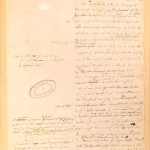 During his meeting at City Tavern with Adams the day before, the Dutch experience of 1581 had also crossed his mind. In 1581, the Netherlands were ruled by King Philip of Spain. The council of the Netherlands provinces passed the Plakkaat van Verlatinghe, known in English as the Act of Abjuration. The act contended that King Philip, by his conduct, had given up or “abjured” his right to be the sovereign power over the Netherlands. It too contained a list of the king’s abuses. The disputes involved religious controversy as well. The Netherlands declared they would be exchanging the rule of one sovereign (King Philip of Spain) for the rule of another (Duke of Anjou who was the brother of the King of France).
During his meeting at City Tavern with Adams the day before, the Dutch experience of 1581 had also crossed his mind. In 1581, the Netherlands were ruled by King Philip of Spain. The council of the Netherlands provinces passed the Plakkaat van Verlatinghe, known in English as the Act of Abjuration. The act contended that King Philip, by his conduct, had given up or “abjured” his right to be the sovereign power over the Netherlands. It too contained a list of the king’s abuses. The disputes involved religious controversy as well. The Netherlands declared they would be exchanging the rule of one sovereign (King Philip of Spain) for the rule of another (Duke of Anjou who was the brother of the King of France).
While Jefferson recognized that the Dutch had not sought true independence, the idea that a king’s conduct could make his rule illegitimate was one that could have value in the American declaration. He made a note to incorporate that thought into his writing.
The 1689 English Bill of Rights
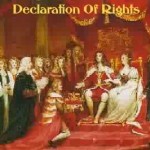 The last potential precedent from history for Jefferson to consider was the 1689 English Bill of Rights. John Dickinson was fond of referring to this as part of the English tradition guaranteeing the rights of Englishmen. Jefferson and Richard Henry Lee had discussed this as well. That agreement between England’s aristocracy and a Dutch invader hardly protected Americans if indeed it possessed any real value to Englishmen. The aristocracy had “invited” the Protestant Willem to invade and depose the Catholic King James. This “Bill of Rights” was another example of the dangers of religion in government, and a supposed declaration meant to secure the status of the ruling class.
The last potential precedent from history for Jefferson to consider was the 1689 English Bill of Rights. John Dickinson was fond of referring to this as part of the English tradition guaranteeing the rights of Englishmen. Jefferson and Richard Henry Lee had discussed this as well. That agreement between England’s aristocracy and a Dutch invader hardly protected Americans if indeed it possessed any real value to Englishmen. The aristocracy had “invited” the Protestant Willem to invade and depose the Catholic King James. This “Bill of Rights” was another example of the dangers of religion in government, and a supposed declaration meant to secure the status of the ruling class.
Jefferson considered the events that had placed the Dutch Willem (who would change his Dutch name to the more English William) and his wife on the English throne. They would reign as King William and Queen Mary. He noted the small irony in his dismissal of the 1689 English Bill of Rights. The place where Jefferson had studied and honed the analytical skills he was bringing to bear at this moment, William and Mary College, named after the Dutch invader and his English bride who had deposed her father.
Was there value in these historical “precedents”?
Jefferson noted patterns in the possible historical precedents. Each instance had a religious element. Each included an effort to replace one despotic royal sovereign with another despotic royal sovereign. While the records of these disputes over power employed terms like “rights” and “liberties”, it was clear the goal of each was to enhance or secure the place of an established nobility or upper class. While these events and documents contained lessons, they were not precedents for the contemplated American action. Beyond the list of grievances, these documents were not remotely related to the American Mind.
It was clear however that the commonality of a list of grievances against the sovereign personally and the arguments that a king had forfeited his right to rule served a clear purpose. These concepts belonged in his draft declaration.
The lists and statements of royal forfeiture were the manner in which a revolution was announced, and the Americans were announcing a revolution.
Continued at: Birthing of the Declaration of Independence: Part Six, Defining the American Mind






[…] were in Virginia. In Part Four, Jefferson’s selection to draft the declaration takes place. In Part Five, Jefferson considers the lessons of history as he begins work on the Declaration. In Part Six, […]